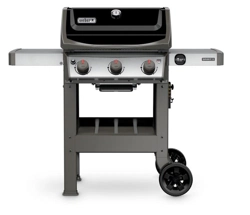Loading ...
Loading ...
Loading ...

14
m WARNING: Turn your barbecue o and wait for
it to cool before thoroughly cleaning.
m WARNING: Over time, the development of
rough surfaces can form on the FLAVORIZER
BARS. Wearing gloves is recommended when
handling. Do not clean FLAVORIZER BARS or
cooking grills in a sink, dishwasher, or self-
cleaning oven.
m WARNING: When cleaning the burners, never
use a brush that has already been used to
clean the cooking grills. Never put sharp
objects into the burner port holes.
m CAUTION: Do not place any barbecue
components onto the side tables as they may
scratch the paint or stainless steel surfaces.
m CAUTION: Do not use any of the following
to clean your barbecue: abrasive stainless
steel polishes or paints, cleaners that contain
acid, mineral spirits or xylene, oven cleaner,
abrasive cleansers (kitchen cleansers), or
abrasive cleaning pads.
Product Care
Cleaning and Maintenance
Cleaning the Inside of the Barbecue
Over time, the performance of your barbecue can
diminish if it has not been maintained properly.
Low temperatures, uneven heat, and food sticking
to cooking grills are all signs that cleaning and
maintenance are overdue. When your barbecue is o
and cool, start by cleaning the inside, from the top
down. A thorough cleaning is recommended at least
twice a year. Consistent use may require quarterly
cleanings.
Cleaning the Lid
From time to time you may notice “paint-like” flakes
on the inside of the lid. During use, grease and smoke
vapors slowly change into carbon and deposit on the
inside of your lid. These deposits will eventually peel,
and looks very similar to paint. These deposits are
non-toxic, but the flakes could fall onto your food if you
do not clean the lid regularly.
1) Brush the carbonized grease from the inside of the
lid with a stainless steel bristle grill brush (A). To
minimize further build-up, the inside of the lid can
be wiped with a paper towel after barbecuing while
the barbecue is still warm (nothot).
Cleaning the Cooking Grills
If you have been cleaning your cooking grills as
recommended, the debris on your grills should be
minimal.
1) With grills installed, brush the debris o your
cooking grill with a stainless steel bristle grill
brush(B).
2) Take the grills out and set aside.
Cleaning the FLAVORIZERBARS
FLAVORIZER BARS catch drippings that smoke and
sizzle, adding flavor to your food. Any drippings that
are not vaporized by the FLAVORIZER BARS are
funneled away from the burners. This helps prevent
flare-ups inside of your barbecue, and protects the
burners from getting clogged.
1) Scrape the FLAVORIZER BARS with a plastic
scraper(C).
2) If necessary, brush the FLAVORIZER BARS with a
stainless steel bristle grill brush.
3) Remove FLAVORIZER BARS and set aside.
Cleaning the Burners
Two areas on the burners that are key to optimum
performance are the ports (small openings running
along the length of the burners) and the spider/insect
screens on the ends of the burner. Keeping these
areas clean is essential for safe operation.
Cleaning the Burner Ports
1) Use a clean stainless steel bristle grill brush
to clean the outside of the burners by brushing
across the top of the burner ports (D). Do not brush
lengthwise.along the tube, as this will only brush
debris from one port to another.
2) When cleaning burner 1, avoid damaging the
ignition electrode by carefully brushing around
it(E).
Cleaning the Spider Screens
1) Locate the ends of the burners on the underside of
the control panel where they meet the valves.
2) Clean the spider/insect screens on each of the
burners using a soft bristle brush (F).
A
C
D
E
F
B
Loading ...
Loading ...
Loading ...
